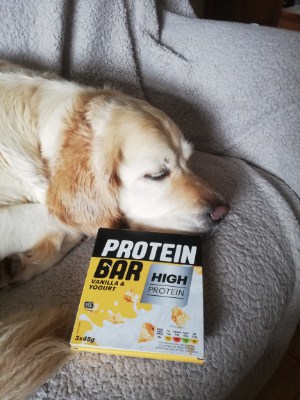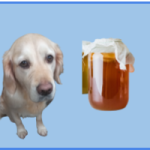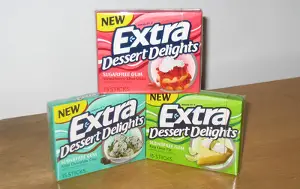
[1] What is a protein bar?
So you were in a bit of a rush to get to the gym this morning?
Bleary eyed, with the sound of your alarm still ringing in your ears you grabbed everything you needed and headed out for the door.
Only to realise as you finished your session that you left your stash of protein bars on the side and that Fido has probably eaten them for breakfast.
But how bad can things get if your dog snacks on a protein bar or two?
Keep reading to find out the good news and the not so good news.
[1a] My dog has eaten a protein bar. What should I do?
If your dog has eaten a protein bar then, in all likelihood, the worst thing that will happen is an upset stomach.
And so in answer to your question about what you should do, the answer is to get ready to clean up after a bad dose of diarrhea.
And the reason for my confidence is that most top brands of protein bar do not contain any toxic ingredients.
But there are some important exceptions here.
And I want to briefly mention three.
Firstly, some protein bars will contain xylitol which is an artificial ingredient that is lethal to your dog (this article believes that xylitol is used by “cheaper brands”.)
Secondly, many protein bars contain chocolate in some form or other. Cocoa is lethal to dogs.
And thirdly, the sugar content in most protein bars is very high- around 30%.
But I will look at all of those exceptions in much more detail later.
To start this article, let us take a look at some of the best selling brands of protein bars.
[2] What are some of the top brands of protein bars?
I have looked at four brands of protein bars, which are some of the biggest sellers and some of the brands which are the focus of Google searches.
And those brands are:
- Quest protein bars
- Pure protein bars
- Luna protein bars
- Perfect protein bars
Having identified the brands that I will be looking more closely into, it is time to take a closer look at the main ingredients in each of these bars.
How dangerous to our dogs can a protein bar be?
[3] What are the main ingredients in the bars?
I think that the best way to look at the main ingredients is to look at each brand of bar in turn.
After a quick look, it seems to me that each of these brands offers well over a dozen different flavours of protein bars- which is simply amazing (and a little overwhelming!)
Fortunately, no matter what the flavour, the main ingredients for each brand remain the same.
Otherwise, I might have been looking at lists of ingredients for hours…
Quest
A Quest protein bar contains three main ingredients:
- Protein blend
- soluble corn fibre and
- almonds
Luna
The three biggest ingredients in a Luna protein bar are:
- Brown rice syrup
- Rolled oats
- Soy protein.
Perfect
And Perfect protein bars are mostly made with:
- Peanut butter (no mention of xylitol),
- honey and
- non fat dry milk
Pure
And that leaves us with the Pure range of protein brands.
Their bars are made predominantly with a “protein blend” which is a mix of whey and milk proteins.
Having looked at the ingredients that the four big brands use in their protein bars, I want to move on and look at whether any of these ingredients are toxic?
[4] Are these ingredients toxic?
Nothing on the list of main ingredients from any brand is toxic or lethal to a dog.
On the flip side, none of the ingredients are particularly nutritious for a dog either.
Most of the ingredients used in these bars are highly processed and very high in sugar content.
I mean, soluble corn fiber and brown rice syrup.
They won’t kill your dog but they won’t do your dog any favours either.
As I said earlier, just make sure that the rubber gloves are on standby!
The most harmless ingredients seem to be the rolled oats.
And below I have listed the exact amount of sugar in each of these bars- and it is a bit shocking!
Quest: 6%
Luna: 30%
Perfect: 25%
Pure: 32%
Many of us, in our minds, would associate a protein bar with a healthy snack but a quick look at the sugar content tells another story.
The only brand which seems to have a reasonable level of sugar is Quest.
Why is xylitol toxic to dogs?
At the start of this article, I mentioned that the artificial sweetener xylitol is potentially lethal to dogs.
It is thought that as little as 50mg/ lb of a dog’s body weight could kill a dog.
Now, I was a bit concerned about the Perfect protein bars because one of their base ingredients is peanut butter and xylitol is widely used in some brands of peanut butter.
But fortunately, there is no mention of xylitol in their ingredient list.
But there are some protein bars that do contain xylitol and for the sake of your dog, it is best if you don’t buy them.
When a dog consumes xylitol it triggers an increase in the level of insulin within a dog’s blood.
In response to this, a dog’s blood sugar level rapidly decreases, which can cause hypoglycemia.
What are the symptoms of xylitol poisoning?
Important symptoms to look out for in a dog that has ingested xylitol are a general lethargy and a complete lack of coordination.
Your dog will be unusually quiet but if they do try to move they will stumble around a lot.
And, if this sounds like your dog, you need to phone your vet as soon as you can.
Xylitol poisoning cannot be treated at home and can only be treated by a veterinarian.
Chocolate flavoured protein bars
Having looked at how toxic xylitol is, it is time to look at another popular ingredient in our protein bars, chocolate.
Of the twenty different flavours of protein bars on the Quest website, a staggering eleven flavours have the word chocolate in their name.
The Luna protein bar, made by Clif bar, comes in four different flavours, all of them chocolate.
The Perfect range of protein bars comes in thirteen different flavours- five of which have chocolate in the name.
And finally, Pure protein bars come in twelve different flavours and six of those have chocolate in the name.
Chocolate toxicity with dogs
We can see from this that people love chocolate flavoured protein bars, they just can’t seem to get enough of them.
But do any of these bars contain enough chocolate to pose a real threat to your dog’s health?
Chocolate is poisonous for dogs because it contains the chemicals theobromine and caffeine.
Both of these chemicals are classed as methylxanthines, which are stimulants.
If your dog eats too much chocolate it might be stimulated to such an extent that it results in seizures or a heart attack.
Because these methylxanthines are found in the cocoa bean, the type of chocolate that your dog has eaten is important.
And there is a sliding scale of danger, starting with the most dangerous first:
- Cocoa powder
- Baking chocolate
- Dark chocolate
- Milk chocolate
It is a bit confusing and so the best thing to use is a chocolate toxicity calculator.
All you need to know is the weight of your dog, the type of chocolate they ate and how much of it they ate.
The calculator will then advise you if you need to book your dog an emergency appointment with the vet.
Are chocolate protein bars toxic for dogs?
This is a really tricky one because I can’t find any specific details about how much chocolate or cocoa is in each bar.
The calculator above assumes that your dog has eaten chocolate and not a chocolate flavoured food (which is what a protein bar is.)
Quest’s double chocolate chunk bar, which I figured is the bar with the most amount of chocolate in, has it listed 7th in the ingredient list.
And when you consider that each bar weighs on 60g, if your dog ate two 60g chocolate bars they would be safe.
And so, I can safely say that if your dog ate three or four of your chocolate flavoured protein bars then they won’t have chocolate poisoning.
But the trouble is that if you buy your chocolate protein bars in boxes and your dog eats all of the bars in the box, that is twelve bars.
And that amount warrants a phone call to your vet.





